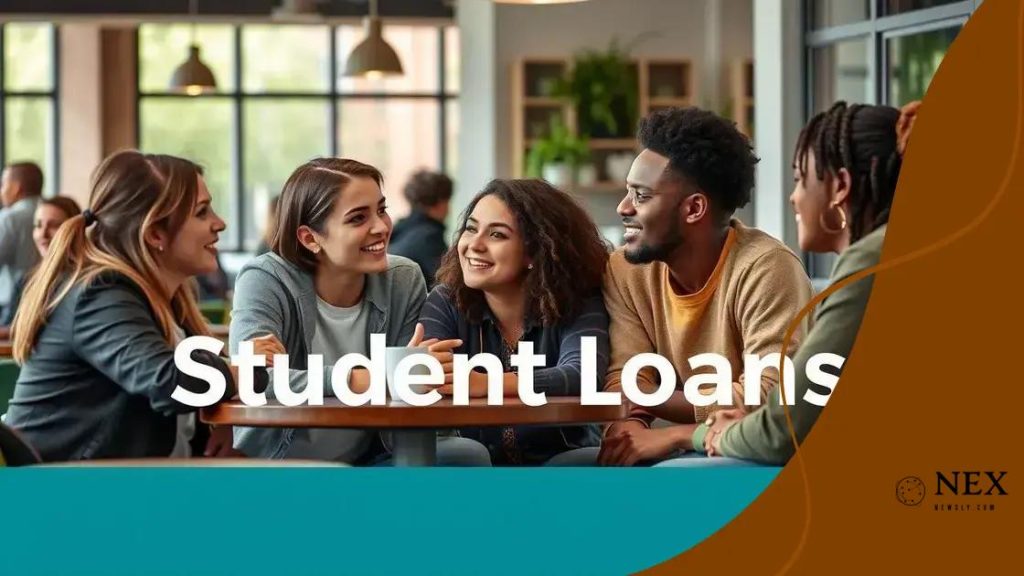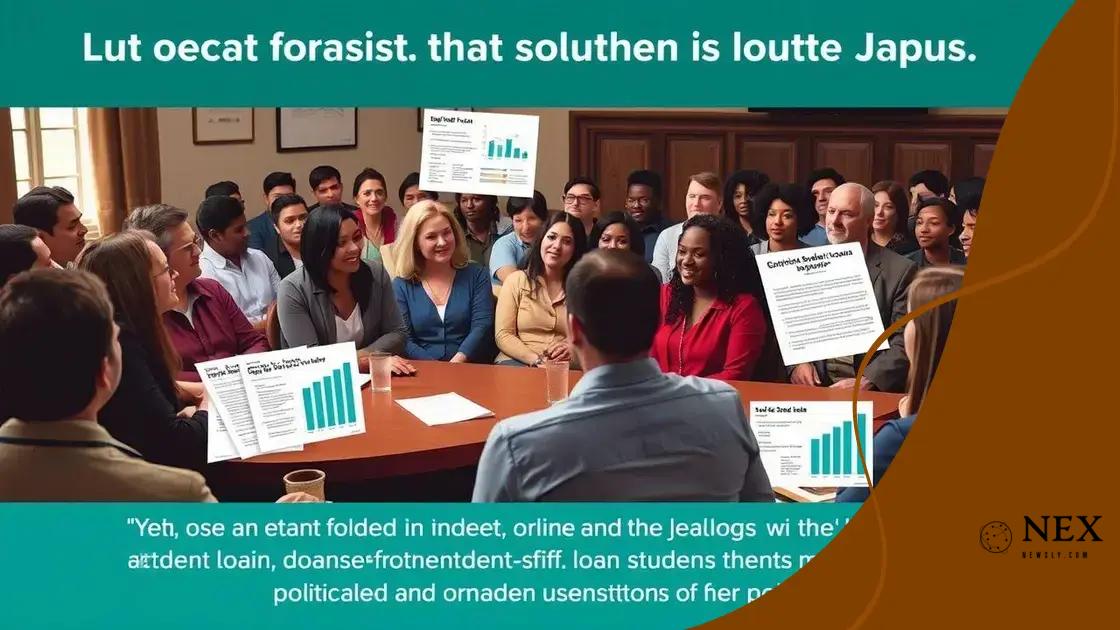Student loan forgiveness updates: What you need to know

Anúncios
Student loan forgiveness updates refer to changes in eligibility, application processes, and available programs designed to help borrowers reduce or eliminate their student loan debt.
Student loan forgiveness updates are crucial to understand, especially if you’re one of the many borrowers hoping for relief. With changing policies, knowing your options could make a big difference in your financial future. Let’s dive into the latest developments and what they entail for you.
Anúncios
Current federal loan forgiveness programs
Understanding current federal loan forgiveness programs is essential for anyone looking to ease their student debt burden. These programs can provide significant financial relief, but knowing your options and eligibility is key.
Types of Forgiveness Programs
There are several federal loan forgiveness programs available, each designed to help specific groups of borrowers. These include:
- Public Service Loan Forgiveness (PSLF): This program forgives loans for individuals working in qualifying public service jobs.
- Teacher Loan Forgiveness: Teachers in low-income schools can receive forgiveness after five years of service.
- Borrower Defense to Repayment: This program allows borrowers to discharge federal student loans if their school misled them.
- Income-Driven Repayment Forgiveness: Remaining loan balances can be forgiven after 20 or 25 years of qualifying payments.
To apply for these programs, you must meet specific requirements. It’s important to stay informed about your eligibility and any changes to the programs. Regularly checking the Federal Student Aid website can provide you with the latest updates.
Anúncios
Eligibility Requirements
Each program has unique eligibility criteria. For instance, to qualify for the Public Service Loan Forgiveness, you must work full-time for a qualifying employer and make 120 qualifying payments. Similarly, teachers seeking the Teacher Loan Forgiveness must serve in a specific role in designated low-income schools.
These requirements can sometimes be complex and confusing. Consider consulting with a financial advisor or a student loan expert to navigate the process effectively. Keeping detailed records of your payment history and employment can also make applying for forgiveness easier.
Staying updated on federal loan forgiveness programs is vital, especially since regulations can change. Make sure to keep track of deadlines and program updates to maximize your benefits.
Recent changes in eligibility criteria
Recent changes in eligibility criteria for student loan forgiveness programs have created new opportunities for borrowers. Understanding these updates is essential to take full advantage of what’s available.
Key Updates to Eligibility
Several forgiveness programs have seen modifications to their eligibility requirements. Here are some key changes:
- Expanded Income-Driven Repayment (IDR) Plans: Borrowers can now qualify for forgiveness under updated repayment plan terms.
- Temporary Waivers: Some programs are offering temporary waivers to help borrowers who may have previously been unable to qualify.
- Public Service Requirements: Several adjustments have been made regarding employment in public service, aiming to simplify the application process.
These changes aim to make it easier for a wider range of borrowers to qualify for loan forgiveness. It’s important to stay informed about how these criteria may impact you.
Understanding New Criteria
With recent updates, it’s crucial to check that your loans are eligible. Many borrowers may not realize that changes in their employment status can affect their eligibility. For instance, if you recently shifted to a qualifying public service job, you might find yourself able to apply for forgiveness sooner.
Also, remember that keeping accurate records of your employment and payment history can support your claims for forgiveness. Sometimes, it helps to consult a financial advisor or student loan expert to ensure you’re on the right path, especially with these new criteria.
As changes continue to roll out, ensure you are aware of all the options available under federal programs. Regularly visiting the Federal Student Aid website can help keep you updated on all pertinent changes that could benefit your situation.
Impact of political shifts on student loans

The impact of political shifts on student loans is significant and can directly influence forgiveness programs. Understanding these dynamics is crucial for borrowers aiming to navigate their student debt.
Recent Political Changes
Changes in leadership and policies often lead to shifts in educational funding and loan forgiveness programs. For instance, recent elections have brought new proposals aimed at reforming student loans, which might open new doors for borrowers seeking relief.
- Changes in Administration: New administrations may introduce or repeal regulations affecting student loans.
- Legislation Introduced: Legislation that aims to change the landscape of student loan forgiveness can emerge based on election outcomes.
- Budget Allocations: Political decisions can directly impact how much funding is available for loan forgiveness programs.
These factors create an ever-evolving environment for current and prospective borrowers. Staying informed about political changes can help you understand how they might affect your student loans.
Understanding the Implications
Political shifts can lead to changes in eligibility criteria, repayment plans, and even the viability of certain forgiveness programs. For example, a push for more funding in education can enhance the public service loan forgiveness options.
Moreover, during election cycles, candidates often highlight their education policies, which can signal potential future changes. It’s wise to pay attention to these discussions, especially if you are close to qualifying for forgiveness or if you are in repayment.
By keeping an eye on the political landscape, borrowers can better prepare for any changes that may arise, ensuring they are ready to take advantage of new opportunities as they become available. Following news related to education and student loans will provide insight and updates vital for your financial health.
How to apply for forgiveness successfully
Applying for student loan forgiveness can be a straightforward process if you know the key steps. Here’s how to apply for forgiveness successfully and increase your chances of approval.
Gather Necessary Documents
Before starting your application, it’s essential to collect all the required documents. Having these on hand will make your application smoother:
- Loan Information: Know the types of loans you have and their statuses.
- Employment Records: Document your current and past jobs, especially if they are public service.
- Income Documentation: Be prepared to show your income to verify eligibility.
With these documents ready, you can proceed with confidence.
Follow Application Guidelines
Each forgiveness program has specific application guidelines. Make sure to read and follow the instructions carefully. In many cases, you can apply online:
- Public Service Loan Forgiveness: Complete the PSLF form and submit it through the Federal Student Aid website.
- Teacher Loan Forgiveness: Use your school’s verification form to confirm your eligibility and submit it during the application period.
Completing these forms accurately is crucial for avoiding delays.
Stay in Contact
After submitting your application, it’s important to stay in contact with your loan servicer. They can provide updates on your application status and let you know if any additional information is needed. Being proactive can prevent hold-ups in the process.
Moreover, consider keeping records of all communications and submissions. This will help if you need to reference your application later. Following up periodically shows your commitment and can help move your application along.
Overall, successfully applying for student loan forgiveness requires proper preparation, understanding of the guidelines, and effective communication. By following these steps diligently, you can enhance your chances of receiving the relief you need.
Resources for further assistance
When seeking to navigate the complexities of student loan forgiveness, having access to resources for further assistance can be invaluable. There are numerous tools and organizations that can help you understand your options and facilitate the process.
Federal Resources
Start by visiting the official Federal Student Aid website. This site offers a plethora of information related to student loans, including forgiveness programs, eligibility criteria, and application guides. You will find tools to:
- Calculate Payments: Understand how much you need to pay to qualify for forgiveness.
- Check Loan Status: Keep track of loans and repayment conditions.
- Find Contact Information: Reach out to loan servicers for personalized assistance.
Utilizing these federal resources is a good starting point for borrowers.
Non-Profit Organizations
Many non-profit organizations provide free consultations and resources regarding student loan forgiveness. Organizations like NAVI and the Student Borrower Protection Center offer:
- Guidance and Counseling: Get advice tailored to your financial situation.
- Workshops: Attend sessions that educate borrowers about their rights and options
- Legal Assistance: Some non-profits even provide legal aid to help disputing incorrect loan servicer decisions.
These resources can empower borrowers to take the necessary steps toward loan forgiveness.
Your Loan Servicer
Your loan servicer is a key resource in your journey toward forgiveness. They can answer specific questions about your loans and provide tailored advice based on your situation. Always feel free to reach out to them, especially when you have questions about eligibility or application processes.
In addition, keeping in touch with your loan servicer can help ensure that you stay abreast of any changes to your loans or the forgiveness programs. Regular communication is crucial for making informed decisions.
By tapping into these resources, you can navigate the student loan forgiveness process more effectively and increase your chances of obtaining the relief you deserve.
In conclusion, understanding the latest updates on student loan forgiveness is vital for borrowers looking to alleviate their debt. By staying informed about current programs, eligibility criteria, and the application processes, you can better navigate the complexities of student loans. Utilizing the resources available, such as federal websites and non-profit organizations, can significantly enhance your chances of obtaining forgiveness. Remember, proactive communication with your loan servicer and continuous monitoring of political changes can ensure you take advantage of all opportunities that come your way. Ultimately, these steps can lead you toward financial relief and a brighter future.
FAQ – Student Loan Forgiveness Information
What is student loan forgiveness?
Student loan forgiveness is the cancellation of some or all of your student loan debt, often granted based on specific eligibility criteria.
Who qualifies for student loan forgiveness?
Eligibility varies by program, but generally includes public service workers, teachers, and borrowers with specific repayment plans.
How do I apply for student loan forgiveness?
You can apply by completing the relevant forms for the forgiveness program you qualify for, usually available on the Federal Student Aid website.
Are there resources available to help with the application process?
Yes, there are many resources available, including federal websites and non-profit organizations that offer guidance on the application process and eligibility.





